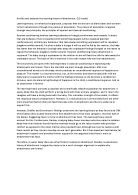Outline and evaluate Bowlby's theory of attachment (12 marks)
Outline and evaluate Bowlby’s theory of attachment. (12 marks)
Bowlby proposed that attachment is an innate, evolved mechanism to ensure survival. Babies are born very vulnerable and it is essential they have someone to care for them. Therefore behaviours have evolved to make attachment more likely. Bowlby argues babies display behaviours that encourages the adult to care for and feed them, known as ‘social releasers’ such as crying and gurgling. The concept of attachment being innate is supported by Lorenz’s early study of goslings. He found that when goslings were separated from their mother, they formed an attachment with the first moving thing they saw, (him).
There are several key features to Bowlby’s proposal aside from it being innate. Firstly, Bowlby argued that we have one key attachment that is more significant than the others. This idea he termed monotropy. Typically this is between a mother and her child, but this is not always the case. He said this significant attachment or relationship will form a template or ‘internal working model’ for later relationships. If they have a secure, stable, loving relationship with their caregiver, they will go on to form stable, secure, trusting relationships in later life, and vice versa for unsecure, unstable and unloving early relationships. This he termed his ‘continuity hypothesis’. In addition, he stated that there is a ‘critical period’ in which it is essential a child forms an attachment or there will be long term consequences for the child.









